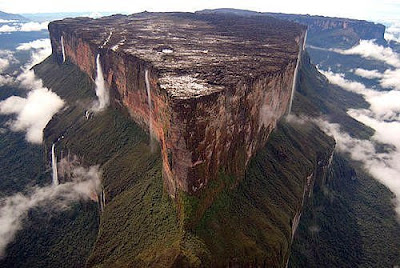Facts About Mount Roraima - strangefacts
- Mount Roraima (mountain, South America) giant flat-topped mountain, or mesa, in the Pakaraima Mountains of the Guiana Highlands , at the point where the boundaries of Brazil, Venezuela, and Guyana meet
- About 9 miles (14 km) long and 9,094 feet (2,772 metres) high, it is the source of many rivers of Guyana, and of the Amazon and Orinoco
- Mount Roraima is a pretty remarkable place. It is a tabletop mountain with sheer 400-metre high cliffs on all sides
- There is only one ‘easy’ way up, on a natural staircase-like ramp on the Venezuelan side – to get up any other way takes and experienced rock climber
- On the top of the mountain it rains almost every day, washing away most of the nutrients for plants to grow and creating a unique landscape on the bare sandstone surface
- This also creates some of the highest waterfalls in the world over the sides (Angel falls is located on a similar tabletop mountain some 130 miles away)
- Though there are only a few marshes on the mountain where vegetation can grow properly, these contain many species unique to the mountain, including a species of carnivorous pitcher plant
- The mountain marks the border between Venezuela, Brazil and Guyana, although more than three quarters of the mountain is in Venezuelan territory
- It is the highest mountain in Guyana, but Venezuela and Brazil have higher mountains. The triple border point on the summit is at 5°12'08N, 60°44'07W
- Roraima lies on the Guiana Shield in the southeastern corner of Venezuela's 30,000 km² Canaima National Park, which is roughly located in the Gran Sabana region
- The tabletop mountains of the park are considered some of the oldest geological formations on Earth, dating back to the Precambrian Era, some two billion years ago
- The average height of the plateau is about 2,500 metres (8,200 feet), making it the highest point for distance of 549.44 kilometres (341.48 miles) in any direction
- The nearest peak that is taller is Cerro Marahuaca, to the west-southwest
- Despite the fact the steep sides of the plateau make it difficult to access, it was the first major tepui to be climbed: Sir Everard im Thurn walked up a forested ramp in December 1884 to scale the strangely wind-and-water sculpted plateau
- This is the same route hikers take today
- It is thought that the reports from early Victorian expeditions to the mountain inspired Sir Arthur Conan Doyle to write his classic adventure yarn, The Lost World, in 1912 - now made into countless films
- Since long before the arrival of European explorers in Venezuela the mountain has held a special significance for the indigenous people of the region and it is central to many of their myths and legends
- The Pemon Indians of the Gran Sabana see Roraima as the stump of a mighty tree that once held all the fruits and tuberous vegetables in the world
- Felled by one of their ancestors, the tree crashed to the ground, unleashing a terrible flood. "Roroi" in the Pemon language means blue-green and "ma" means great
- Mount Roraima has been climbed on a few occasions from the Guyana and Brazil sides, but as the mountain is entirely bordered on both these sides by enormous sheer cliffs that include high overhanging (negative-inclination) stretches, these are extremely difficult and technical rock climbing routes
